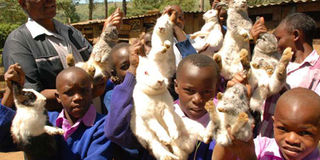A must-have startup guide on rabbit keeping

Kiamaina Primary School in Nakuru County display some rabbits they rear at the institution. PHOTO | SULEIMAN MBATIAH
What you need to know:
- Rabbits have a unique habit of passing two types of manure. The dry pellets passed during the day contain non-utilisable fibrous materials. The other types of manure are called wet pellets and are passed early morning.
- Rabbits are broadly grouped according to the purpose they are kept for; meat, fur and pet.
- Rabbits prefer kindling in burrows, thus, should be provided with a nesting box. No two mature males should be kept in the same hutch as this may result to regular fights that may be fatal.
Rabbit rearing is easy, comes with a lot of fun and it is a profitable venture. The animals are mainly reared for pelt (skin), food, fur and as pets. Initially, rabbit rearing was a reserve for young boys as a hobby, but the trend is gradually shifting to commercial farming. The animals are non-ruminant herbivores, thus, have an enlarged hindgut (colon and caeca), which functions like the rumen (foregut) in digestion of fibrous plant materials.
Rabbits have a unique habit of passing two types of manure. The dry pellets passed during the day contain non-utilisable fibrous materials. The other types of manure are called wet pellets and are passed early morning.
They contain nutrients recovered from hindgut digestion. Therefore, provide the animals with feeds rich in fibre such as hay. Lush green feeds should be avoided as they cause bloat, which may be fatal. Above all, provide them with clean water at all times.
BREEDS AND BREEDING
Rabbits are broadly grouped according to the purpose they are kept for; meat, fur and pet. My focus will be on meat breeds;
Giant breeds: They have a faster growth rate and weigh up to 9kg. They attain sexual maturity late (nine months) and have less frequent and small litter sizes. They also have higher bone to meat ratio compared to other breeds. An example is the Flemish Giant.
Medium breeds: They have high growth rate and weigh up to 5kg with good management; attain sexual maturity early (six months), are prolific breeders and best for meat production. California and New Zealand White are good examples.
Small breeds: They have a high growth rate and weigh up to 3kg with good management. They attain sexual maturity early, are very prolific breeders and hardy. Examples are Kenya White and Dutch breeds.
When choosing the breeding buck and does, always consider those that have a faster growth rate, are hardy, docile, prolific and with good mothering ability. Consider locally bred rabbits since they are adapted to the environment.
MANAGEMENT PRACTICES
Rabbits prefer kindling in burrows, thus, should be provided with a nesting box. No two mature males should be kept in the same hutch as this may result to regular fights that may be fatal. Minimise time for feeding and cleaning to limit stress and panic. It is common to find a doe that neglect’s its kindles. Such does should be trained to suckle, otherwise kindles may die of starvation. Other general management practices include; castrating, tagging and disease and parasites control.
Health management
Ensure your rabbits are properly housed in clean houses. Respiratory and digestive diseases and disorders are the most common. Parasites include manges (ectoparasite) and worms (endoparasites). Respiratory diseases arise from stuffy pens and dusty feeds; digestive disorders from poor feeding and unhygienic conditions; manges (skin disease) due to parasites; while worms results from failure to deworm.
Challenges
Due to the low popularity of rabbit farming compared to other livestock, there has been little efforts in research, extension and promotion. Major challenges include;
a. Hard to get manufactured feeds.
b. There is no formal marketing system.
c. Inadequate knowledge among extension agents on diseases, diagnosis and treatment.
d. There is no specific medicines for rabbits .
e. Health benefits of rabbit meat are not widely known.
Marketing opportunities
First, there are a few rabbit butcheries. Second, rabbit eating culture is picking up, including in hotels. Third, there is a potential for chain stores. Other than meat, rabbits give manure, which when composted with its urine can be sold as a high nitrogen organic fertiliser. Pelts can also be cured and be sold to tanneries for our leather industries.




